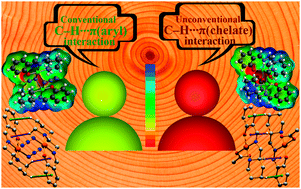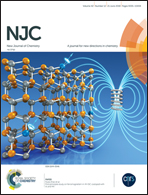Quantifying conventional C–H⋯π(aryl) and unconventional C–H⋯π(chelate) interactions in dinuclear Cu(ii) complexes: experimental observations, Hirshfeld surface and theoretical DFT study†
Abstract
Two novel Cu(II) complexes, [Cu2L2(μ1.1-N3)2] (1) and [Cu2L2(μ1.1-CH3COO−)2]·2H2O (2), have been synthesized using a tridentate NNO donor Schiff base ligand, 2-[(piperidin-2-ylmethylimino)-methyl]-phenol (HL) and azide or acetate as the co-ligand. Both the structures exhibit elongated (4 + 1) square pyramidal geometries and are centrosymmetric dimers, in which the metal centers are connected by the double μ1.1-azido and acetate bridges. Both complexes exhibit unconventional C–H⋯π(chelate) interaction along with conventional C–H⋯π(aryl) supramolecular interactions in the solid-state assembly. A detailed analysis of Hirshfeld surfaces and fingerprint plots elegantly quantifies the interactions within the crystal structures, revealing significant similarities and differences in the interactions experienced by the complexes. The intricate combinations of C–H⋯π(chelate) and C–H⋯π(aryl) interactions are fully described along with the computational studies. The binding energies associated with the noncovalent interactions observed in the crystal structures and the interplay between them have been calculated using theoretical DFT calculations. Moreover, the interactions have been characterized by using both Bader's theory of “atoms-in-molecules” and the noncovalent interaction plot (NCI plot).



 Please wait while we load your content...
Please wait while we load your content...